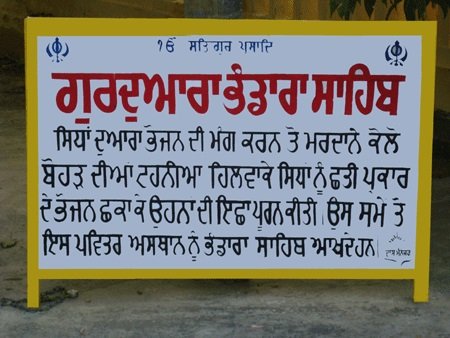NIDHAN SINGH, SANT (1882-1947), holy man popularly known as Hazur Sahibvale, was born the son of Bhai Uttam Singh of the village of Nidalori in Hoshiarpur district of the Punjab. He received religious instruction at the hands of Sant Divan Singh, popular in the area for his holiness. He left his home at the age of 20 and enlisted in the 5th Probyn`s Horse, a cavalry regiment of the Indian army, atJharisi. But he resigned within a year and set out on pilgrimage to Takhl Sachkhand Sri Hazur Sahib, Nanded, where he took up his permanent abode and found his calling in work in Guru ka Larigar.
BAZIDPUR, village 7 km southeast of Firozpur Cantonment (31° 55`N, 74° 36`E) along the FirozpurLudhiana highway, is sacred to Guru Gobind Singh (1666-1708), who passed through here in 1706 after the battle of Muktsar. Gurdwara Gurusar, formerly known as Tittarsar after a legendary partridge (tittar, in Punjabi), marks the site where Guru Gobind Singh had encamped, and was first constructed in the form of a small Manji Sahib by Bishan Singh Ahluvalia, an official under Maharaja Ranjit Singh (1780-1839).
BHUP SINGH, SARDAR, remembered as Raja Bhup Singh in local lore, was the chief of the Sikh principality of Ropar, during the earlier half of the nineteenth century. Little is known about his life except that in 1808-09 he, along with Deva Singh, was in possession of Ropar and its adjacent districts including Khizrabad and Mianpur, a tract covering 115 villages with an estimated annual revenue of Rs 53,000. He was probably a grandson of Sardar Hari Singh of Dallevalia misi, who, according to Lepel.
DIKKH, village 12 km to the north of Maur Kalan (30° 4`N, 75° 14`E) in Bathinda district of the Punjab, is sacred to Guru Tegh Bahadur, who visited it during his travels in these parts. According to Sakhi Pothi, an humble Sikh entreated the Guru to come and put up in his house. The Guru accepted his invitation. He blessed his host who had served him with complete devotion. The Sikh, who was childless, had four sons thereafter.A memorial platform raised in honour of the Guru, about 200 metres west of the village, was later buried under sand; but, as memory of the Guru`s visit survived, it was uncovered again and a singleroom gurdwara established on the site in 1917.
- 1
- 2





